By James Dobbins, Raphael S. Cohen, Nathan Chandler, Bryan Frederick, Edward Geist, Paul DeLuca, Forrest E. Morgan, Howard J. Shatz, Brent Williams, RAND Corporation, 2019
Editor's Note: There must be no doubt that Russia's invasion and war in Ukraine have been provoked by the United States and its NATO allies. In my essay, Humanity at Crossroads, I have documented this with references to the policy debates in Washington. I have already also posted "Why John Mearsheimer Blames the U.S. for the Crisis in Ukraine," a March 1 interview with the Chicago University political scientist who has been a dissenter to the Wolfowitz Doctrine first formulated on February 18, 1992, in response to the collapse of the Soviet Union. What follows is a summary of a policy brief published by RAND Corporation on how to contain Russia as a challenger to the U.S. imperialist hegemony. Here is part of Wikipedia's entry for what RAND Corporation is: "The RAND ("research and development") is an American nonprofit global policy think tank created in 1948 by Douglas Aircraft Company to offer research and analysis to the United States Armed Forces. It is financed by the U.S. government and private endowments, corporations, universities, and private individuals.
"The company has grown to assist other governments, international organizations, private companies, and foundations with a host of defense and non-defense issues, including healthcare. RAND aims for interdisciplinary and quantitative problem solving by translating theoretical concepts from formal economics and the physical sciences into novel applications in other areas, using applied science and operations research."
RAND has approximately 1,850 employees. KN
❖
This brief summarizes a report that comprehensively examines nonviolent, cost-imposing options that the United States and its allies could pursue across economic, political, and military areas to stress—overextend and unbalance—Russia’s economy and armed forces and the regime's political standing at home and abroad. Some of the options examined are clearly more promising than others, but any would need to be evaluated in terms of the overall U.S. strategy for dealing with Russia, which neither the report nor this brief has attempted to do.
Today’s Russia suffers from many vulnerabilities—oil and gas prices well below peak that have caused a drop in living standards, economic sanctions that have furthered that decline, an aging and soon-to-be-declining population, and increasing authoritarianism under Vladimir Putin’s now-continued rule. Such vulnerabilities are coupled with deep-seated (if exaggerated) anxieties about the possibility of Western-inspired regime change, loss of great power status, and even military attack.
Despite these vulnerabilities and anxieties, Russia remains a powerful country that still manages to be a U.S. peer competitor in a few key domains. Recognizing that some level of competition with Russia is inevitable, RAND researchers conducted a qualitative assessment of “cost-imposing options” that could unbalance and overextend Russia. Such cost-imposing options could place new burdens on Russia, ideally heavier burdens than would be imposed on the United States for pursuing those options.
The work builds on the concept of long-term strategic competition developed during the Cold War, some of which originated at RAND. A seminal 1972 RAND report posited that the United States needed to shift its strategic thinking away from trying to stay ahead of the Soviet Union in all dimensions and toward trying to control the competition and channel it into areas of U.S. advantage. If this shift could be made successfully, the report concluded, the United States could prompt the Soviet Union to shift its limited resources into areas that posed less of a threat.
The new report applies this concept to today’s Russia. A team of RAND experts developed economic, geopolitical, ideological, informational, and military options and qualitatively assessed them in terms of their likelihood of success in extending Russia, their benefits, and their risks and costs.
Figure 1. Russian Petroleum Exports Are Declining
SOURCE: United Nations (UN), UN Comtrade Database, electronic online database, 2017.
Economic Cost-Imposing Measures
Expanding U.S. energy production would stress Russia’s economy, potentially constraining its government budget and, by extension, its defense spending. By adopting policies that expand world supply and depress global prices, the United States can limit Russian revenue. Doing so entails little cost or risk, produces second-order benefits for the U.S. economy, and does not need multilateral endorsement.
Imposing deeper trade and financial sanctions would also likely degrade the Russian economy, especially if such sanctions are comprehensive and multilateral. Thus, their effectiveness will depend on the willingness of other countries to join in such a process. But sanctions come with costs and, depending on their severity, considerable risks.
Increasing Europe’s ability to import gas from suppliers other than Russia could economically extend Russia and buffer Europe against Russian energy coercion. Europe is slowly moving in this direction by building regasification plants for liquefied natural gas (LNG). But to be truly effective, this option would need global LNG markets to become more flexible than they already are and would need LNG to become more price-competitive with Russian gas.
Encouraging the emigration from Russia of skilled labor and well-educated youth has few costs or risks and could help the United States and other receiving countries and hurt Russia, but any effects—both positive for receiving countries and negative for Russia—would be difficult to notice except over a very long period. This option also has a low likelihood of extending Russia.
NOTE: For all the tables in this brief, high and low rankings for costs and risks are inverted in desirability from the rest of the table; i.e., low costs are good in the same way that a high likelihood of success is. Thus, a low cost is shaded in light orange while a low likelihood of success is shaded in dark orange. All assessments listed in the tables in this brief are based on analysis by the report’s authors.
Geopolitical Cost-Imposing Measures
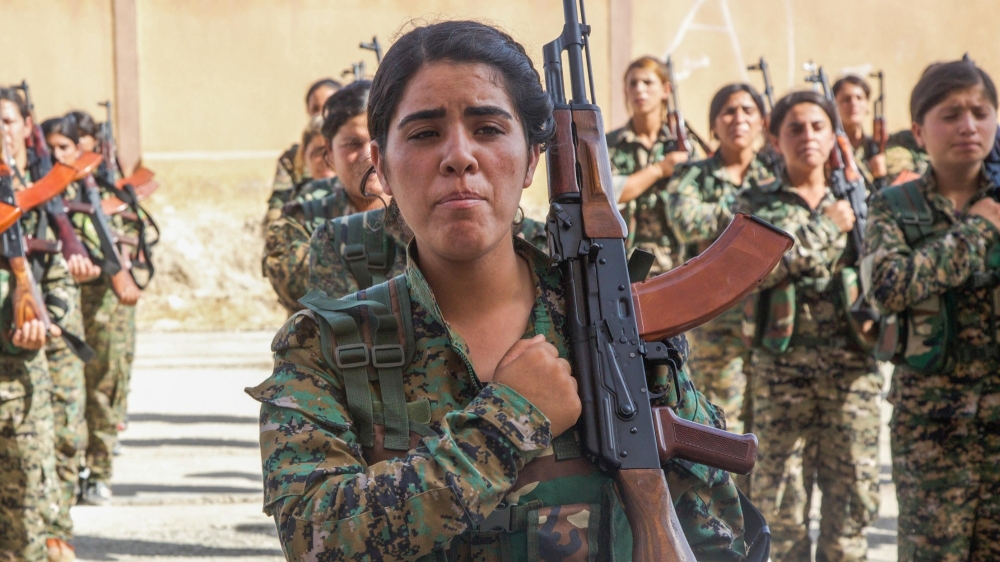
Syrian Democratic Forces trainees, representing an equal number of Arab and Kurdish volunteers, stand in formation at their graduation ceremony in northern Syria, August 9, 2017.
Photo by Sgt. Mitchell Ryan/DoD
Providing lethal aid to Ukraine would exploit Russia’s greatest point of external vulnerability. But any increase in U.S. military arms and advice to Ukraine would need to be carefully calibrated to increase the costs to Russia of sustaining its existing commitment without provoking a much wider conflict in which Russia, by reason of proximity, would have significant advantages.
Increasing support to the Syrian rebels could jeopardize other U.S. policy priorities, such as combating radical Islamic terrorism, and could risk further destabilizing the entire region. Furthermore, this option might not even be feasible, given the radicalization, fragmentation, and decline of the Syrian opposition.
Promoting liberalization in Belarus likely would not succeed and could provoke a strong Russian response, one that would result in a general deterioration of the security environment in Europe and a setback for U.S. policy.
Expanding ties in the South Caucasus—competing economically with Russia—would be difficult because of geography and history.
Reducing Russian influence in Central Asia would be very difficult and could prove costly. Increased engagement is unlikely to extend Russia much economically and likely to be disproportionately costly for the United States.
Flip Transnistria and expel the Russian troops from the region would be a blow to Russian prestige, but it would also save Moscow money and quite possibly impose additional costs on the United States and its allies.
NOTE: For all the tables in this brief, high and low rankings for costs and risks are inverted in desirability from the rest of the table; i.e., low costs are good in the same way that a high likelihood of success is. Thus, a low cost is shaded in light orange while a low likelihood of success is shaded in dark orange. All assessments listed in the tables in this brief are based on analysis by the report’s authors.
Ideological and Informational Cost-Imposing Measures
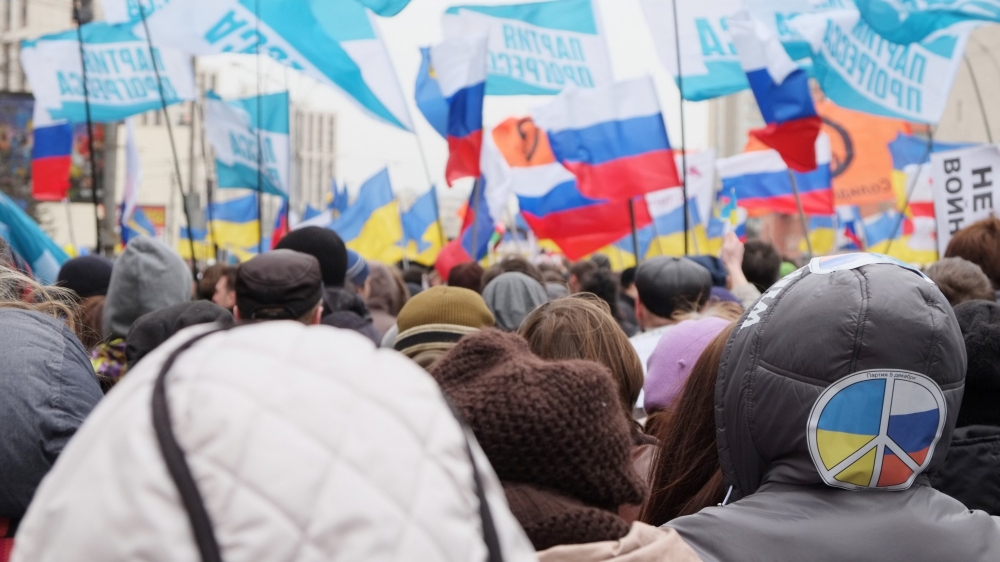
Muscovites protesting the war in Ukraine and Russia’s support of separatism in the Crimea on the Circular Boulevards in Moscow on March 15, 2014.
Photo by Dmitry Vereshchagin/Adobe Stock
Diminishing faith in the Russian electoral system would be difficult because of state control over most media sources. Doing so could increase discontent with the regime, but there are serious risks that the Kremlin could increase repression or lash out and pursue a diversionary conflict abroad that might run counter to Western interests.
Creating the perception that the regime is not pursuing the public interest could focus on widespread, large-scale corruption and further challenge the legitimacy of the state. But it is hard to assess whether political volatility and protests would lead to a more extended Russia—less able or inclined to threaten Western interests abroad—or to a Russia more inclined to lash out in retaliation or to distract, making this a high-risk option.
Encouraging domestic protests and other nonviolent resistance would focus on distracting or destabilizing the Russian regime and reducing the likelihood that it would pursue aggressive actions abroad, but the risks are high and it would be difficult for Western governments to directly increase the incidence or intensity of anti-regime activities in Russia.
Undermining Russia’s image abroad would focus on diminishing Russian standing and influence, thus undercutting regime claims of restoring Russia to its former glory. Further sanctions, the removal of Russia from non-UN international forums, and boycotting such events as the World Cup could be implemented by Western states and would damage Russian prestige. But the extent to which these steps would damage Russian domestic stability is uncertain.
While none of these measures has a high probability of success, any or all of them would prey on the Russian regime’s deepest anxieties and might be employed as a deterrent threat to diminish Russia’s active disinformation and subversion campaigns abroad.
NOTE: For all the tables in this brief, high and low rankings for costs and risks are inverted in desirability from the rest of the table; i.e., low costs are good in the same way that a high likelihood of success is. Thus, a low cost is shaded in light orange while a low likelihood of success is shaded in dark orange. All assessments listed in the tables in this brief are based on analysis by the report’s authors.
Air and Space Cost-Imposing Measures
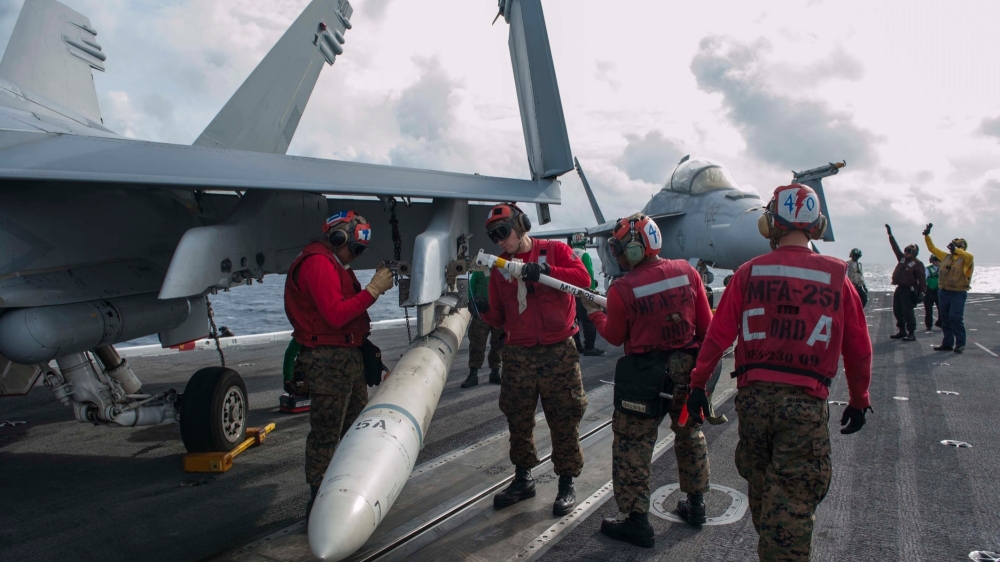
Marines assigned to the Thunderbolts of Marine Fighter Attack Squadron (VMFA) 251 remove a training AGM-88 HARM from an F/A-18C Hornet on the flight deck of the Nimitz-class aircraft carrier USS Theodore Roosevelt (CVN 71).
Photo by Anthony N. Hilkowski/DVIDS
Reposturing bombers within easy striking range of key Russian strategic targets has a high likelihood of success and would certainly get Moscow’s attention and raise Russian anxieties; the costs and risks of this option are low as long as the bombers are based out of range of most of Russia’s theater ballistic and ground-based cruise missiles.
Reposturing fighters so that they are closer to their targets than bombers as a way to achieve higher sortie rates to compensate for their smaller payloads would likely concern Moscow even more than reposturing bombers, but the likelihood of success is low and risks are high. Because each aircraft would need to fly multiple sorties during a conventional conflict, Russian leaders would probably be confident that they could destroy many fighters on the ground and shut down their deployment airfields early on with few or no additions to their missile inventory.
Deploying additional tactical nuclear weapons to locations in Europe and Asia could heighten Russia’s anxiety enough to significantly increase investments in its air defenses. In conjunction with the bomber option, it has a high likelihood of success, but deploying more such weapons might lead Moscow to react in ways contrary to U.S. and allied interests.
Repositioning U.S. and allied ballistic missile defense systems to better engage Russian ballistic missiles would also alarm Moscow but would likely be the least effective option because Russia could easily saturate current systems and any planned upgrades with a small percentage of its existing missile inventory, leaving many missiles still available to hold U.S. and allied targets at risk.
There are also ways to get Russia to extend itself in strategic competition. In terms of benefits, such developments would exploit Moscow’s demonstrated fear of U.S. airpower capabilities and doctrines. Developing new low-observable, long-range bombers, or simply adding significantly more of types that are already available or programmed (B-2s and B-21s) would be worrisome for Moscow, as would developing autonomous or remotely piloted strike aircraft and producing them in high numbers. All options would likely incentivize Moscow to devote ever-greater resources to making its command and control systems harder, more mobile, and more redundant.
A key risk of these options is being drawn into arms races that result in cost-imposing strategies directed against the United States. For example, investing in ballistic missile defense systems and space-based weapons would alarm Moscow, but Russia could defend against such developments by taking measures that would probably be considerably cheaper than the costs of these systems to the United States.
As for likelihood of success, some options are good cost-imposing strategies, but some—such as investing more in HARMs or other electronic warfare technologies—are clearly better than others, and some approaches should be avoided, such as those that focus on space-based weapons or ballistic missile defense systems.
The United States might goad Russia into a costly arms race by breaking out of the nuclear arms control regime, but the benefits are unlikely to outweigh U.S. costs. The financial costs of a nuclear arms race would probably be as high for the United States as they would be for Russia, perhaps higher. But the more serious costs would be political and strategic.
NOTE: For all the tables in this brief, high and low rankings for costs and risks are inverted in desirability from the rest of the table; i.e., low costs are good in the same way that a high likelihood of success is. Thus, a low cost is shaded in light orange while a low likelihood of success is shaded in dark orange. All assessments listed in the tables in this brief are based on analysis by the report’s authors.
Maritime Cost-Imposing Measures
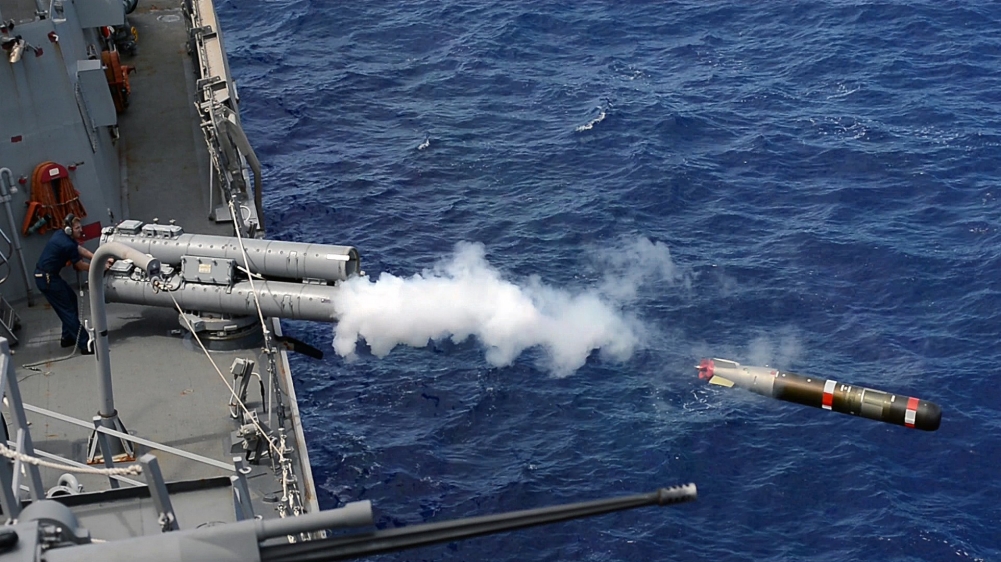
A U.S. sailor aboard the guided missile destroyer USS Mustin (DDG 89) fires a torpedo at a simulated target during Valiant Shield 2014 in the Pacific Ocean September 18, 2014.
Photo by Petty Officer 3rd Class Declan Barnes/DVIDS
Increasing U.S. and allied naval force posture and presence in Russia’s operating areas could force Russia to increase its naval investments, diverting investments from potentially more dangerous areas. But the size of investment required to reconstitute a true blue-water naval capability makes it unlikely that Russia could be compelled or enticed to do so.
Increasing naval R&D efforts would focus on developing new weapons that allow U.S. submarines to threaten a broader set of targets or enhance their ability to threaten Russian nuclear ballistic missile submarines (SSBNs), which could impose anti-submarine warfare costs on Russia. There are limited risks, but success depends on being able to develop these capabilities and on whether they are sufficiently capable of influencing Russian expenditures.
Shifting nuclear posture toward SSBNs would entail increasing the percentage of the U.S. nuclear triad assigned to SSBNs by increasing the size of that fleet. While it might force Russia to invest in capabilities that can operate in a blue-water environment in two oceans and would reduce risks to U.S. strategic posture, the option is unlikely to entice Russia into changing its strategy and, thus, extending itself.
Checking the Black Sea buildup would involve deploying strengthened North Atlantic Treaty Organization (NATO) anti-access and area denial over the Black Sea—perhaps in the form of long-range, land-based anti-ship missiles—to drive up the cost of defending Russian bases in Crimea and lower the benefit to Russia of having seized this area. Russia would certainly mount a vigorous diplomatic and informational campaign to dissuade coastal NATO and non-NATO states from participating. Also, operating in the Black Sea is politically and logistically more difficult for the U.S. Navy than the Russian Navy; it is also more dangerous for the former in a conflict.
NOTE: For all the tables in this brief, high and low rankings for costs and risks are inverted in desirability from the rest of the table; i.e., low costs are good in the same way that a high likelihood of success is. Thus, a low cost is shaded in light orange while a low likelihood of success is shaded in dark orange. All assessments listed in the tables in this brief are based on analysis by the report’s authors.
Land and Multidomain Cost-Imposing Measures
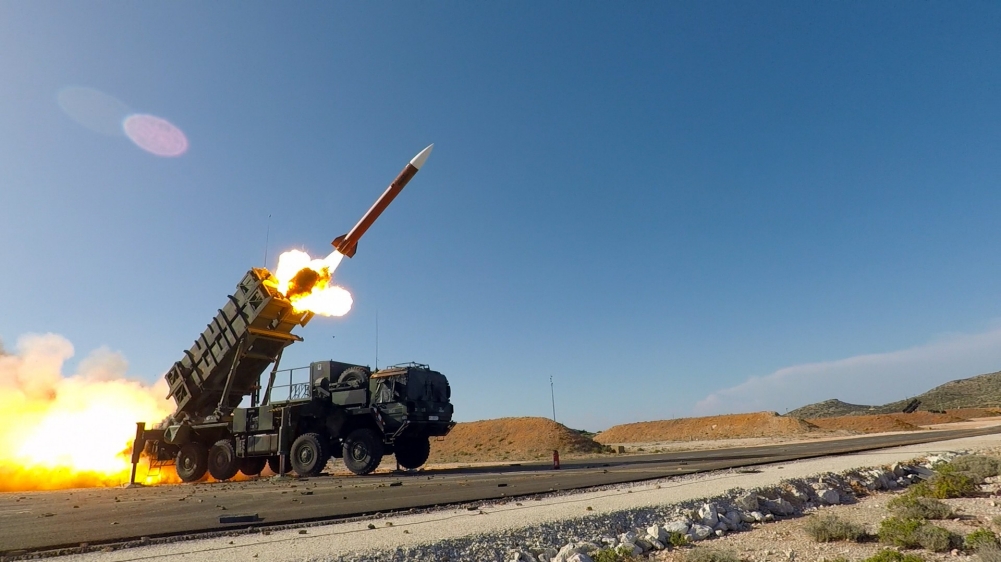
Exercise Artemis Strike was a German-led tactical live-fire exercise with live Patriot and Stinger missiles at the NATO Missile Firing Installation in Chania, Greece, from October 31 to November 9, 2017. More than 200 U.S. soldiers and approximately 650 German airmen participated in the realistic training within a combined construct, exercising the rigors associated with force projection and educating operators on their air missile defense systems.
Photo by Anthony Sweeney/DVIDS
Increasing U.S. forces in Europe, increasing European NATO member ground capabilities, and deploying a large number of NATO forces on the Russian border would likely have only limited effects on extending Russia. All the options would enhance deterrence, but the risks vary. A general increase in NATO ground force capabilities in Europe—including closing European NATO member readiness gaps and increasing the number of U.S. forces stationed in traditional locations in Western Europe—would have limited risks. But large-scale deployments on Russia’s borders would increase the risk of conflict with Russia, particularly if perceived as challenging Russia’s position in eastern Ukraine, Belarus, or the Caucasus.
Increasing the size and frequency of NATO exercises in Europe may help to enhance readiness and deterrence, but it is unlikely to prompt a costly Russian response unless the exercises also send risky signals. Large-scale NATO exercises held near Russia’s borders and exercises that practice counterattack or offensive scenarios could be perceived as showing the intent and willingness to consider offensive operations. For example, a NATO exercise simulating a counterattack to retake NATO territory lost to advancing Russian forces might look like an exercise to prepare for an invasion of a piece of Russian territory, such as Kaliningrad.
Developing but not deploying an intermediate-range missile could bring Russia back into conformity with the Intermediate-Range Nuclear Forces Treaty but could also prompt an acceleration of Russian missile programs. Withdrawing from that treaty and building the missiles but not deploying them in Europe would add little to U.S. capabilities and would probably prompt Russia to deploy such missiles itself—and, perhaps, invest more in ballistic missile defense. Taking the further step of deploying the missiles to Europe, assuming that NATO allies were willing, would also almost certainly prompt a Russian response, potentially involving substantial resources, or at least the diversion of substantial resources from other defense spending, though it is hard to assess what share would be directed toward defensive capabilities versus offensive or retaliatory ones.
Incremental investments in new technologies to counter Russian air defenses and increase U.S. long-range fires could significantly improve defense and deterrence while compelling increased Russian investment in countermeasures. Investments in more-revolutionary, next-generation technologies could have even greater effects, given the Russian concerns about new physical principles, but depending on the capability, such investments could also risk strategic stability by threatening the Russian regime and leadership security in a crisis.
NOTE: For all the tables in this brief, high and low rankings for costs and risks are inverted in desirability from the rest of the table; i.e., low costs are good in the same way that a high likelihood of success is. Thus, a low cost is shaded in light orange while a low likelihood of success is shaded in dark orange. All assessments listed in the tables in this brief are based on analysis by the report’s authors.
Implications for the Army
The task of “extending Russia” need not fall primarily on the Army or even the U.S. armed forces as a whole. Indeed, the most promising ways to extend Russia—those with the highest benefit, the lowest risk, and greatest likelihood of success—likely fall outside the military domain. Russia is not seeking military parity with the United States and, thus, might simply choose not to respond to some U.S. military actions (e.g., shifts in naval presence); other U.S. military actions (e.g., posturing forces closer to Russia) could ultimately prove more costly to the United States than to Russia. Still, our findings have at least three major implications for the Army.
- The U.S. Army should rebuild its linguistic and analytical expertise on Russia. Because Russia does pose a long-term threat, the Army needs to develop the human capital to engage in this strategic competition.
- The Army should consider investing and encouraging the other services to invest more in capabilities, such as Army Tactical Missile Systems, Indirect Fire Protection Capability Increment 2, longer-range anti-air defense, and other systems designed to counter Russian anti-access and area denial capabilities. The Army also might consider spending some R&D resources on less-mature, more-futuristic systems (e.g., swarm unmanned aerial vehicles or remote combat vehicles). While these measures would likely be insufficient in themselves to greatly extend Russia, they would benefit U.S. deterrence efforts and could augment a broader whole-of-government policy.
- Even if the Army were not directly involved in extending Russia per se, it would play a key role in mitigating the possible blowback. All the options to extend Russia incur some risk. As a result, enhancing U.S. deterrence posture in Europe and increasing U.S. military capabilities (e.g., an enhanced Javelin or active protection systems for Army vehicles) might need to go hand in hand with any move to extend Russia, as a way of hedging against the chance of tensions with Russia escalating into conflict.
Conclusions
The most-promising options to “extend Russia” are those that directly address its vulnerabilities, anxieties, and strengths, exploiting areas of weakness while undermining Russia’s current advantages. In that regard, Russia’s greatest vulnerability, in any competition with the United States, is its economy, which is comparatively small and highly dependent on energy exports. Russian leadership’s greatest anxiety stems from the stability and durability of the regime, and Russia’s greatest strengths are in the military and info-war realms. The table below draws from the earlier tables to identify the most-promising options.
Most of the options discussed, including those listed here, are in some sense escalatory, and most would likely prompt some Russian counterescalation. Thus, besides the specific risks associated with each option, there is additional risk attached to a generally intensified competition with a nuclear-armed adversary to consider. This means that every option must be deliberately planned and carefully calibrated to achieve the desired effect. Finally, although Russia will bear the cost of this increased competition less easily than the United States will, both sides will have to divert national resources from other purposes. Extending Russia for its own sake is not a sufficient basis in most cases to consider the options discussed here. Rather, the options must be considered in the broader context of national policy based on defense, deterrence, and—where U.S. and Russian interests align—cooperation.
NOTE: For all the tables in this brief, high and low rankings for costs and risks are inverted in desirability from the rest of the table; i.e., low costs are good in the same way that a high likelihood of success is. Thus, a low cost is shaded in light orange while a low likelihood of success is shaded in dark orange. All assessments listed in the tables in this brief are based on analysis by the report’s authors.

No comments:
Post a Comment